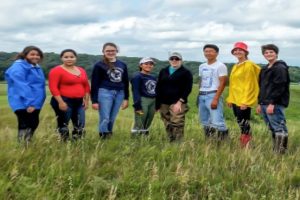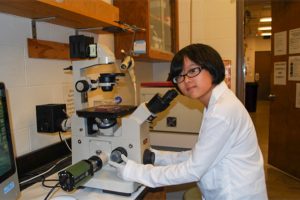Summer Means Science for Several DMPS Students

Hoover students Megan Brown, Lal Zuali and Diana Rodriguez conducted research this summer at the University of Iowa’s Iowa Lakeside Laboratory.
There’s no better place to be during summertime than at the lake. Here in Iowa Lake Okoboji is the most popular attraction this side of the state fair. Everybody knows there’s no better place for research on bio-organisms and ecosystems than the state’s greatest lake, right? That’s why the Regents Resource Center/Lakeside Lab is located there.
Okay, so most people go for fun on the water and at Arnolds Park; not to peer through microscopes and dive into test tubes. But the lab was what drew a select group of DMPS student-scientists who seized the opportunity to work at an advanced level and assist in research projects being conducted by the University of Iowa.
Megan Brown, Lal Zuali and Diana Rodriguez are Hoover students who spent two weeks at Okoboji this summer but were hardly on vacation. They were studying diatoms, you know, algae that are among the most common types of phytoplankton.
“This was the second year of a partnership with the Iowa Lakeside Laboratory Project at the University of Iowa,” Maureen Griffin told the school board at their August 16th meeting.
Griffin is the Director of the STEM Academy at Hoover and was introducing the summer scientists who gave brief oral reports on their work and tried to express them in layman lingo.
Another group of DMPS researchers commuted back and forth to Ames for six weeks to participate in the highly selective Young Engineer & Scientist (YES) program at Iowa State University.
Mai Dang is a Hoover student whose work in Ames was in the areas of genetics and cell biology. She studied the potential for stem cell transplantation in zebrafish.
“Stem cells reproduce quickly and can differentiate (into other types of cells),” she explained to the board members. “Cancer cells contain stem cells so we were looking at ways to isolate them and cure it,” she went on bashfully, as though not to insult the stewards of the largest school district in the state by contrasting the fact that while their responsibilities were on hold during intermission she went off to summer school at a nearby research university to work on curing cancer.
Donald Gee is a Central Academy IB student from Johnston who studied the importance of wetlands to Great Plains ecology. Clad in casual bermuda shorts instead of his lab coat he talked about how ag states like Iowa once were anxious to convert natural wetlands to farmland and now are reversing that conversion as a strategy to reduce nitrates in runoff and improve water quality.
“I spent about half of my time in the field and half in the lab,” he said, working on a topic that figures to be right near the top of the agenda when the state legislature reconvenes next January. By then Donald will be a semester closer to high school graduation.
Meshach Zarwie starts his senior year at North next week. In preparation for it he worked at ISU’s Center for Biorenewable Chemicals (CBiRC) on alternatives to fossil fuels as carbon sources for biofuel production. Glucose and glycerin, for instance, what with their clostridium carboxidivorans and all.
Not present at the board meeting but included in the group’s PowerPoint summary were others like Dalecio Henderson, Triet Ly and Princess Zoaryan from North, who assisted ISU grad research assistants with experiments in areas ranging from cosmic rays to DNA purification.
Select DMPS teachers, too, spend time boning up at CBiRC every summer. How else would they keep pace with their students?
School’s cool for the precocious cohort that spent all those hot weeks in not so leisurely labs, staying sharp. And next year begins next week, not a moment too soon.






